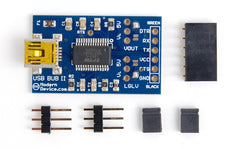USB BUB II
- Vendor: Modern Device
- Type: Interface
The USB BUB-II board is a flexible active USB connector with many applications. It uses a branded FT232R chip, not a clone.
This board has features not found on some other USB boards.
- A polyfuse to protect the USB line from short circuits.
- Two LEDs showing serial activity on the TX/RX lines.
- A configurable shunt to switch the logic levels between 3.3 and 5 volts, independently from the output voltage shunt. Default=3.3v, correct for JeeNodes
- A configurable shunt to switch the output voltage between 3.3 and 5 volts. The FT232R chip generates 3.3v from the incoming USB 5.0v - remember that it’s only good for up to 50 mA of load (that's fine for testing sketches if lightly loaded from added 'Plugs' and/or radio module on reduced transmit power). Default=5.0v, correct for JeeNodes
- Provision to add an SMD 3.3V regulator for higher output currents.
- The pin order of the header matches an FTDI RS232 cable (this is correct for the JeeNode / BBB / RBBB / LilyPad / Arduino Pro pin header). The DTR line is present for generating 'RESET' - this is more reliable than using the quirky RTS line.
The USB-BUB II has key parts already mounted and tested. Chose from the additional headers and shunts included in the pack and it's ready to solder up and go.
The USB BUB-II mates with a mini USB A cable (not included). This is the same type often used as a digital camera connector, so you can recycle one you may already have. If not, chose the BUB II w/cable option.
If you are just using the BUB to upload sketches and then your node will have its own power feed, you can unplug and use on other nodes. N.B. Don't connect a different power feed with the BUB still plugged in.
USB Instructions and Schematic. Remember to check for the latest driver update. You may need to uninstall older driver versions manually.
Optiboot - When using the Optiboot boot loader (select UNO in the IDE), check the Logic Level option setting (LGLV jumpers on the board). The BUB will upload with Optiboot with either the 5V or 3.3V option soldered, but is not reliable with the option floating (nothing soldered). The older Arduino Deicimila / Duemilanove bootloader works fine with the logic level pin floating (VCCIO - pin 4 on the FTDI chip).


